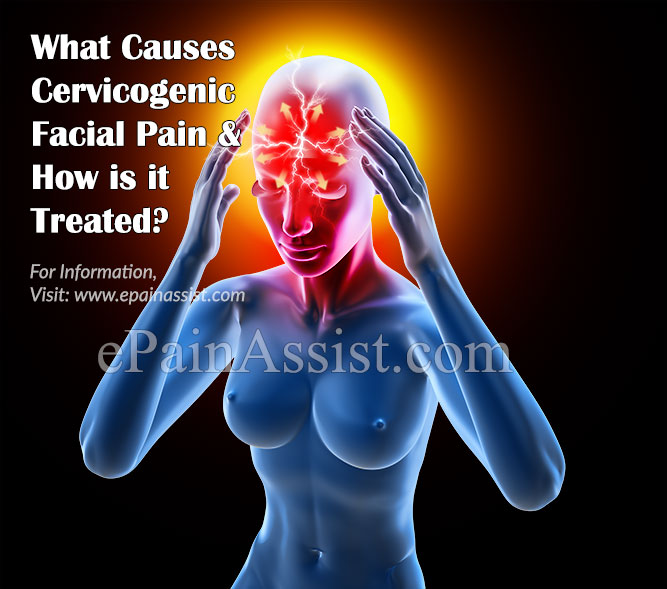About Cervicogenic Facial Pain
Cervicogenic facial pain is a medical condition where you experience tingling sensation or pain on your face when the cervical disc bulges. Usually, it is experienced with neck pain which involves shoulder and sometimes extends to your face as well. In some cases, the cervicogenic facial pain may also occur without neck or shoulder pain. It is important to know the causes and symptoms of cervicogenic facial pain and the treatment for it.
Earlier, it was considered that this condition was caused due to overt sensitivity of the patient, but the primary factor that causes cervicogenic facial pain is the bulging discs in cervical spine.
The spine in humans is made of 24 spinal bones, of which the first seven bones are situated around the neck at the base of the skull, medically termed as cervical spinal bones. The disc between the two spinal bones is a gelatinous disc, which acts as cushioning to decrease the wear and tear. So, when there is a bulging of discs in the cervical spine, it may lead to neck and/or shoulder pain, which gradually extends to your face and causes cervicogenic facial pain in patients.

What Causes Cervicogenic Facial Pain?
Usually, the facial sensations are carried to and fro to the brain via trigeminal nerve, which is basically the cranial nerve that arises from the human brain. The commonest causes of cervicogenic facial pain include those which affect the nerve signals passing through the cervical region. So, when there is a disease in the trigeminal nerve or in its branches, it may cause cervicogenic facial pain or numbness on the face. So, patients suffering from trigeminal nerve disorders like Bell’s palsy, GB Syndrome and Trigeminal Neuralgia are likely to experience such abnormal sensation and burning pain on their face.
The center of the trigeminal nerve that arises in the brain passes through the third segment C3 of the spinal cord prior to innervating in your face. So, the cells of trigeminal nerve and nerve root of C3 gets interconnected partly. When the cervical roots are squeezed together due to a disorder or disease in the cervical spine like spondylosis, slip disc or spinal canal stenosis, the patients are likely to experience cervicogenic facial pain. Abnormal painful sensation on the face can extend to shoulder and neck because of the interconnection. Such pains are medically termed as cervicogenic facial pain.
The painful sensation in cervicogenic facial pain can be unilateral if one side of the neck is affected or can also be present on both sides of the face, depending on the nerves involved. Poor posture, awkward movement of neck, wrong sleeping posture and patterns are often the aggravating causes of cervicogenic facial pain in people.
Symptoms of Cervicogenic Facial Pain
Cervicogenic facial pain is a symptom itself. However, there may be other symptoms of cervicogenic facial pain that patients may experience along with painful sensation and numbness of face. The most common symptoms include numbness and tingling on face, which patients usually experience extending to the neck and shoulder. They may experience neck and shoulder pain while looking upward and backwards with extreme extension of their neck. This is one of the primary symptoms of cervicogenic facial pain.
Patients may also experience tingling facial pain while bending their neck sideways or while looking back. It triggers the tingling facial pain, especially if the pain is originated due to cervical spine disease. Stiffness, restricted movements and pain in neck are also the common symptoms of cervicogenic facial pain due to tensed muscles.
How is Cervicogenic Facial Pain Treated?
It is necessary to find the cause of cervicogenic facial pain to diagnose the condition properly and plan the treatment accordingly.
Examinations like MRI of cervical spine, CT scan of brain and EEG may be ordered to evaluate the causes of cervicogenic facial pain. The doctors may also perform nerve conduction studies and cervical nerve root blockade to confirm the diagnosis.
Treatments for cervicogenic facial pain usually consist of antiepileptic, antidepressant and muscle relaxant medications. Small procedure, which aims at injecting steroids into the affected area of the spine, may help in many cases of cervicogenic facial pain. Another treatment option for cervicogenic facial pain includes Botox Type A to provide relief from numbness, tingling sensation and pain.
Surgery may be considered only in some cases of cervicogenic facial pain, which are severe or which do not respond to conventional treatment. Surgery is the last resort for the patients suffering from severe facial pain caused due to cervical spine disorder. Surgical procedures like discectomy, spinal fusion, laminectomy etc are suggested to patients to help them get relief from the facial pain. It is also suggested to patients who want permanent termination of the problem.
Physical therapy along with medications also works well in most cases of cervicogenic facial pain. Regular physical therapy and therapeutic exercises can help to reduce pain, numbness and tingling sensation caused by cervicogenic facial pain and improve range of movement. It is best to seek medical opinion and follow medical advice to ensure recovery from cervicogenic facial pain without complications.
